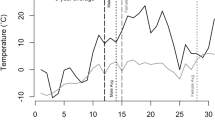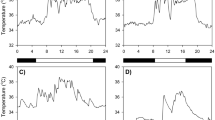Summary
Over-winter torpor patterns of Richardson's ground squirrels hibernating in southern Alberta were monitored with temperature-sensitive radiocollars to determine if these patterns differed between males and females in a manner related to the greater costs of mating effort by males than females. The hibernation season (from immergence to emergence) was composed of three periods: post-immergence euthermy, heterothermy, and pre-emergence euthermy. The hibernation season was shorter for juveniles than adults both among males (< 150 versus 234 days) and females (185 versus 231 days), a reflection of the later immergence into hibernation by juveniles. However, regardless of the absolute duration of hibernation, heterothermy accounted for a smaller proportion of the hibernation season of males (93±5%) than females (98±1%) and, within the heterothermal period, males had shorter torpor bouts and longer inter-torpor arousals. Overall, males spent a smaller proportion of the hibernation season in torpor (85±6%) than females (92±1%). This sexual difference was largely attributable to the longer duration of preemergence euthermy for males than females. Males terminated torpor in January and February, when hibernacula were at their coldest, then remained euthermic for 8.8 days (range 0.5–25.0 days) before emergence. In contrast, females terminated torpor in March, when hibernaculum temperatures were increasing, then remained euthermic for only 1.1 days (range 0.5–2.0 days) before emergence. Males lost less mass per euthermic day during hibernation than females (7.0 versus 9.3 g/day). Males and females hibernated at similar depths (56 cm), but males had larger chambers than females (18 versus 16 cm3/g). Many males, but no females, cached seeds in the hibernaculum. Males met the costs of thermogenesis and euthermy from a combination of fat reserves and food caches, whereas females relied solely on fat. Access to food caches permitted males to terminate torpor several weeks in advance of emergence, during which time they recouped mass and developed sperm in preparation for the forthcoming mating season.
Similar content being viewed by others
References
Barnes BM (1989) Freeze avoidance in a mammal: body temperatures below 0° C in an arctic hibernator. Science 244:1593–1595
Barnes BM, Kretzmann M, Licht P, Zucker I (1986) The influence of hibernation on testis growth and spermatogenesis in the golden-mantled ground squirrel, Spermophilus lateralis. Biol Reprod 35:1289–1297
Barnes BM, Licht P, Zucker I (1987) Temperature dependence of in vitro androgen production in testes from hibernating ground squirrels, Spermophilus lateralis. Can J Zool 65:3020–3023
Davis DE (1984) Pitfalls in the use of ground squirrels for research on hibernation. Can J Zool 62:1656–1658
French AR (1982) Intraspecific differences in the pattern of hibernation in the ground squirrel Spermophilus beldingi. J Comp Physiol 148:83–91
French AR (1989) The impact of variations in energy availability on the time spent torpid during the hibernation season. In: Malan A, Canguilhem B (eds) Living in the cold. John Libbey Eurotext, London Paris, pp 129–135
Geiser F, Kenagy GJ (1988) Torpor duration in relation to temperature and metabolism in hibernating ground squirrels. Physiol Zool 61:442–449
Jameson EW Jr (1964) Patterns of hibernation of captive Citellus lateralis and Eutamias speciosus. J Mammal 45:455–460
Kenagy GJ (1986) Strategies and mechanisms for timing of reproduction and hibernation in ground squirrels. In: Heller HC, Musacchia XJ, Wang LCH (eds) Living in the cold: physiological and biochemical adaptations. Elsevier Science Publ Co New York, pp 383–392
Kenagy GJ (1989) Daily and seasonal uses of energy stores in torpor and hibernation. In: Malan A, Canguilhem B (eds) Living in the cold. John Libbey Eurotext, London Paris, pp 17–24
Kenagy GJ, Sharbaugh SM, Nagy KA (1989) Annual cycle of energy and time expenditure in a golden-mantled ground squirrel population. Oecologia 78:269–282
McLean IG, Towns AJ (1981) Differences in weight changes and the annual cycle of male and female Arctic ground squirrels. Arctic 34:249–254
Michener GR (1983) Spring emergence schedules and vernal behavior of Richardson's ground squirrels: why do males emerge from hibernation before females? Behav Ecol Sociobiol 14:29–38
Michener GR (1984) Age, sex, and species differences in the annual cycles of ground-dwelling sciurids: implications for sociality. In: Murie JO, Michener GR (eds). The biology of ground-dwelling squirrels. Univ Nebraska Press, Lincoln, pp 81–107
Michener GR (1985) Chronology of reproductive events for female Richardson's ground squirrels. J Mammal 66:280–288
Michener GR, Locklear L (1990a) Differential costs of reproductive effort for male and female Richardson's ground squirrels. Ecology 71:855–868
Michener GR, Locklear L (1990b) Over-winter weight loss by Richardson's ground squirrels in relation to sexual differences in mating effort. J Mammal 71:489–499
Murie JO, Harris MA (1982) Annual variation of spring emergence and breeding in Columbian ground squirrels (Spermophilus columbianus). J Mammal 63:431–439
Pengelley ET, Fisher KC (1961) Rhythmical arousal from hibernation in the golden-mantled ground squirrel, Citellus lateralis tescorum. Can J Zool 39:105–120
Shaw WT (1926) The storing habit of the Columbian ground squirrel. Amer Nat 60:367–373
Twente JW, Twente J, Moy RM (1977) Regulation of arousal from hibernation by temperature in three species of Citellus. J Appl Physiol 42:191–195
Wang LCH (1973) Radiotelemetric study of hibernation under natural and laboratory conditions. Am J Physiol 224:673–677
Wang LCH (1979) Time patterns and metabolic rates of natural torpor in the Richardson's ground squirrel. Can J Zool 57:149–155
Young PJ (1990a) Hibernating patterns of free-ranging Columbian ground squirrels, Oecologia 83:504–511
Young PJ (1990b) Structure, location and availability of hibernacula of Columbian ground squirrels (Spermophilus columbianus). Am Midl Nat 123:357–364
Author information
Authors and Affiliations
Rights and permissions
About this article
Cite this article
Michener, G.R. Sexual differences in over-winter torpor patterns of Richardson's ground squirrels in natural hibernacula. Oecologia 89, 397–406 (1992). https://doi.org/10.1007/BF00317418
Received:
Accepted:
Issue Date:
DOI: https://doi.org/10.1007/BF00317418




